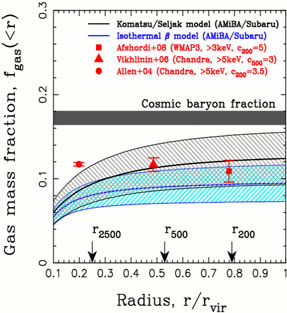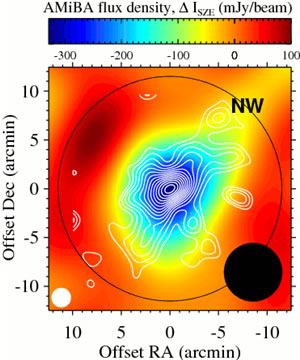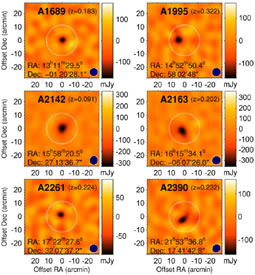|
Home \ Science
ScienceIn April 2007, we detected the first SZE signal with the 7-element YTLA (formerly AMiBA) towards the galaxy cluster A2142 at a redshift of z=0.091 (Ho et al. 2009). This was followed by successful SZE detections towards five more clusters ranging from z=0.18 to 0.32 (Wu et al. 2009). The primary efforts were in the areas of calibration and data reduction, identifying and flagging of bad data, removal of systematic errors, elimination of foreground contamination from local environment, converting output from the lag correlator into u,v data points, Fourier transform of the visibilities, and compensation for poor u,v sampling or dirty beam pattern (Wu et al. 2009). In 2008, much effort was devoted to verifying the quality of the data (Lin et al. 2009; Nishioka et al. 2009; Liu et al. 2010). This involved analysis of the noise characteristics of the data, evaluating the contamination from CMB structures, and compensating for expected point sources in the field of view.
Comparison of the SZE signals with Subaru weak gravitational lensing data allowed us to trace the baryonic and dark matter distributions (Umetsu et al. 2009). The figure on the right hand side shows gas mass fraction profiles averaged over a sample of four clusters from joint YTLA (formerly AMiBA) and Subaru weak lensing observations.
The cluster Abell 2142 is of particular interest since this is our brightest, most-nearby (hence resolvable) SZE cluster at z=0.09, known as a merging cluster. In the figure below, we compare the YTLA (formerly AMiBA) SZE map with the projected mass distribution (white contours) from our weak lensing analysis (Umetsu et al. 2009). The open black circle and the filled black pattern indicate the primary and synthesized beams of YTLA (formerly AMiBA), while the filled white circle represents the weak lensing resolution. Our YTLA (formerly AMiBA) SZE map shows an elliptical structure extending in the northwest (NW) - southeast (SE) direction, similar to the weak lensing (dark matter) distribution shapes. This extended nature of almost 20 arcmin in length from NW to SE is one of the reasons why sampling with the small antennas of 0.6m can be important for providing sensitivity to large scale structures. Other science cases included the comparison of SZE with X-ray data in order to derive cluster angular diameter distances and the Hubble constant (Koch et al., submitted), cluster scaling relations (Huang et al., 2010; Liao et al. 2010), and a study of cluster gas properties constrained by 13-element YTLA (formerly AMiBA) (Molnar et al. 2011). These early science experiments served to demonstrate the potential and performance of YTLA (formerly AMiBA). |
Goals & StrategySurvey of Galaxy Clusters through the Sunyaen-Zeldovich Effects
Measurement of Missing Baryons
Measurement of CMB Polarization Anisotropy
|
>> ASIAA




